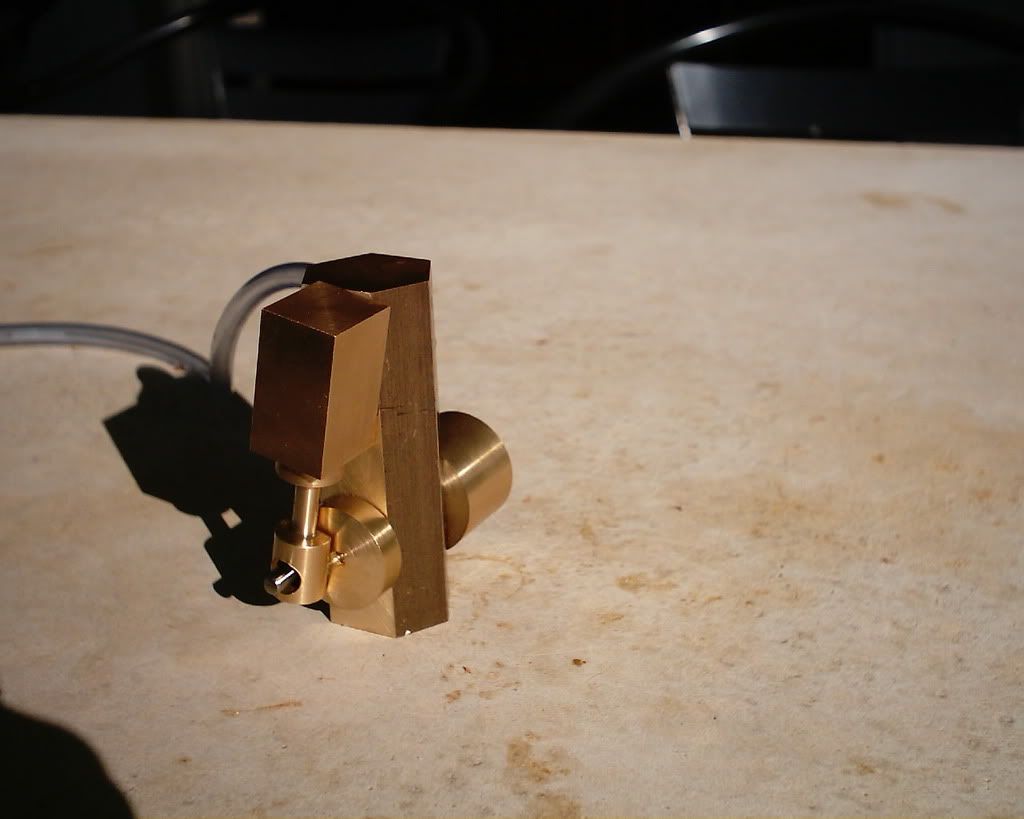You are using an out of date browser. It may not display this or other websites correctly.
You should upgrade or use an alternative browser.
You should upgrade or use an alternative browser.
How Slow Can You Go
- Thread starter bretk
- Start date

Help Support Home Model Engine Machinist Forum:
This site may earn a commission from merchant affiliate
links, including eBay, Amazon, and others.
chuck foster
Well-Known Member
- Joined
- Jul 11, 2007
- Messages
- 704
- Reaction score
- 2
i have seen allot of slow running engines but phil that has to be the slowest 8) 
chuck
chuck
steamboatmodel
Well-Known Member
- Joined
- Sep 7, 2008
- Messages
- 303
- Reaction score
- 7
I remember when taking a pneumatics course the instructor telling us " When in doubt meter out". if you have the needle valve on the exhaust you are creating a back pressure which will work with some valves (piston), but may cause problems with slide valves.fdew said:I don't know if this will work on an engine or not, but on pneumatics, when you want to go slow you put a needle valve on the exhaust, not on the input. It might be worth a try.
Don't do this with steam. Just air.
Frank
Regards,
Gerald
Hi All,
This is my entry for the "How Slow Can You Go" challenge. It's a horizontal mill engine with 1.0" bore and 2.0" stroke.
[ame]http://www.youtube.com/watch?v=1FguWF5nef0[/ame]
I don't think it wins the prize but my grandchildren love to watch it go.
This is my entry for the "How Slow Can You Go" challenge. It's a horizontal mill engine with 1.0" bore and 2.0" stroke.
[ame]http://www.youtube.com/watch?v=1FguWF5nef0[/ame]
I don't think it wins the prize but my grandchildren love to watch it go.
chuck foster
Well-Known Member
- Joined
- Jul 11, 2007
- Messages
- 704
- Reaction score
- 2
i think you have won just by having your grandchildren intersted in the engine 8)
chuck
chuck
I've noticed that some of these engines appear to slow down when the crankpin is moving up and almost stall just as it reaches it's highest point. I assume this is because energy to lift the connecting rod against gravity is being sucked from the engine. If one were to add a counterweight on the flywheel just opposite the crank would the engine be able to run slower?
Anybody want to try it and report back?
earl...
Philjoe5
Well-Known Member
- Joined
- Jul 12, 2007
- Messages
- 1,727
- Reaction score
- 321
Being a fan of the slo-mo engine at some point I'll try a needle valve restrictor on the exhaust and the flywheel counterweight. Both sound feasible and easy enough to try. Just don't know when I'll get to it. ???
Cheers,
Phil
Cheers,
Phil
My understanding of the thing is that the area of the piston is different because of the connecting rod. Since the pressure is constant, the low pressure has grater difficulty to move the piston "up" than "down. :potman said:I've noticed that some of these engines appear to slow down when the crankpin is moving up and almost stall just as it reaches it's highest point. I assume this is because energy to lift the connecting rod against gravity is being sucked from the engine. If one were to add a counterweight on the flywheel just opposite the crank would the engine be able to run slower?
Anybody want to try it and report back?
earl...
rake60
Well-Known Member
- Joined
- Jul 8, 2007
- Messages
- 4,756
- Reaction score
- 124
This is a great thread!
Models that are running this slow are actually producing output power.
It might not get you from 0 to 60 in 5 seconds, but it is just as impressive
for the scale.
It's a model powering a flywheel rather than a flywheel keeping a model
running. Does that make any sense at all? scratch.gif
Beautiful Works Everyone! :bow:
Rick
Models that are running this slow are actually producing output power.
It might not get you from 0 to 60 in 5 seconds, but it is just as impressive
for the scale.
It's a model powering a flywheel rather than a flywheel keeping a model
running. Does that make any sense at all? scratch.gif
Beautiful Works Everyone! :bow:
Rick
dparker
In Rembrance 8/2021
- Joined
- Aug 24, 2007
- Messages
- 218
- Reaction score
- 5
Hello All: This intrigues me I suppose when things are running fast they don't seem to last (Hopped up motors). I enjoy seeing something running slow and lasting forever or at least being reliable.
My examples seem to gather more interest when running slow than running at higher speeds.
McCabes Runner:
[ame]http://www.youtube.com/watch?v=_0OlpkLcddM[/ame]
The Stuart 10V will run very slow if desired (sorry not what we were trying for when these pictures were made) but It may give you somewhat of a idea about the model.
[youtube=425,350]gxPKYE4ZVqg[/youtube]
These engines sit on the shelf most of the time because I know of only two brothers in the neighborhood who are even interested in this kind of toys. It is amazing that the wife can find the remanents of home machine shops at estate sales around the area. I wish we were not so paranoid to let people know our interests but then you open yourself to exposure to the bad element and it is safer to keep your mouth shut I guess.
--don
My examples seem to gather more interest when running slow than running at higher speeds.
McCabes Runner:
[ame]http://www.youtube.com/watch?v=_0OlpkLcddM[/ame]
The Stuart 10V will run very slow if desired (sorry not what we were trying for when these pictures were made) but It may give you somewhat of a idea about the model.
[youtube=425,350]gxPKYE4ZVqg[/youtube]
These engines sit on the shelf most of the time because I know of only two brothers in the neighborhood who are even interested in this kind of toys. It is amazing that the wife can find the remanents of home machine shops at estate sales around the area. I wish we were not so paranoid to let people know our interests but then you open yourself to exposure to the bad element and it is safer to keep your mouth shut I guess.
--don
Philjoe5
Well-Known Member
- Joined
- Jul 12, 2007
- Messages
- 1,727
- Reaction score
- 321
I have a video of my latest engine running at about 30 rpm. I can't get it to run slower without stalling but it only has an hour of break-in time on it. I had thought that this design would allow for slower operating speeds based upon some of the discussion here and elsewhere. Here you go:
[ame]http://www.youtube.com/watch?v=F2c9oPjSbW0[/ame]
I think, for now, I've reached a personal goal and will now move on ;D
Cheers,
Phil
[ame]http://www.youtube.com/watch?v=F2c9oPjSbW0[/ame]
I think, for now, I've reached a personal goal and will now move on ;D
Cheers,
Phil
zeeprogrammer
Well-Known Member
- Joined
- Mar 14, 2009
- Messages
- 3,362
- Reaction score
- 13
That is so cool.
I like slow.
I like slow.
Cheshire Steve
Well-Known Member
- Joined
- Mar 28, 2009
- Messages
- 69
- Reaction score
- 1
Its a shame if a model with an interesting linkage can't be run slow enough to see it. I am currently building a true-to-scale beam engine so people could watch the Watts linkage, and it occurred to me that this one will have to run slow if people are going to appreciate the motion.
Apart from the obvious issues of balancing and reducing friction, there is a fundamental role of scale - they say you can't scale nature - and in some ways this is true. Some things scale with volume (like weight), so at 1/10th scale you have 1/1000th of the weight. Other things scale with area, like force on a piston or area of bearings, and as for flywheels, well they don't scale well at all.
So getting a scale model to run slowly is a real challenge, with best chance being for engines that are multi-cylinder, large scale, and those that had big flywheels to give excellent speed stability (such as those used to generate electricity). You may not get the speed stability, but at least they should run fairly slow.
Has anyone any thoughts on whether the type of piston rings (or no rings) is important in getting slow running ? I am guessing having no rings, but a couple of oil grooves, is lowest friction as this seems the common type for hot air engines.
Steve
Apart from the obvious issues of balancing and reducing friction, there is a fundamental role of scale - they say you can't scale nature - and in some ways this is true. Some things scale with volume (like weight), so at 1/10th scale you have 1/1000th of the weight. Other things scale with area, like force on a piston or area of bearings, and as for flywheels, well they don't scale well at all.
So getting a scale model to run slowly is a real challenge, with best chance being for engines that are multi-cylinder, large scale, and those that had big flywheels to give excellent speed stability (such as those used to generate electricity). You may not get the speed stability, but at least they should run fairly slow.
Has anyone any thoughts on whether the type of piston rings (or no rings) is important in getting slow running ? I am guessing having no rings, but a couple of oil grooves, is lowest friction as this seems the common type for hot air engines.
Steve
DavesWimshurst
DavesWimshurst
- Joined
- Dec 7, 2008
- Messages
- 102
- Reaction score
- 3
K
Kermit
Guest
Cheshire Steve said:Its a shame if a model with an interesting linkage can't be run slow enough to see it. I am currently building a true-to-scale beam engine so people could watch the Watts linkage, and it occurred to me that this one will have to run slow if people are going to appreciate the motion.
Perhaps the key to success with slow speed is to keep a decent amount of pressure, say something that gets you 70 RPM and then INCREASE friction thereby loading down the motor. You should be able to get much slower. try a piece of felt over the top of a rubber band. The more you stretch the rubber the more the friction increase.
Throwing ideas at the wall, hoping something helpful sticks,
Kermit
Similar threads
- Replies
- 20
- Views
- 11K





